‘Behemoth’ is a word which springs to mind or, perhaps more nautically, ‘leviathan’.
- Versatility
- Quality finishes
- Efficient cruising
- Layout works for Kiwi boating
- Suprisingly spacious accommodation
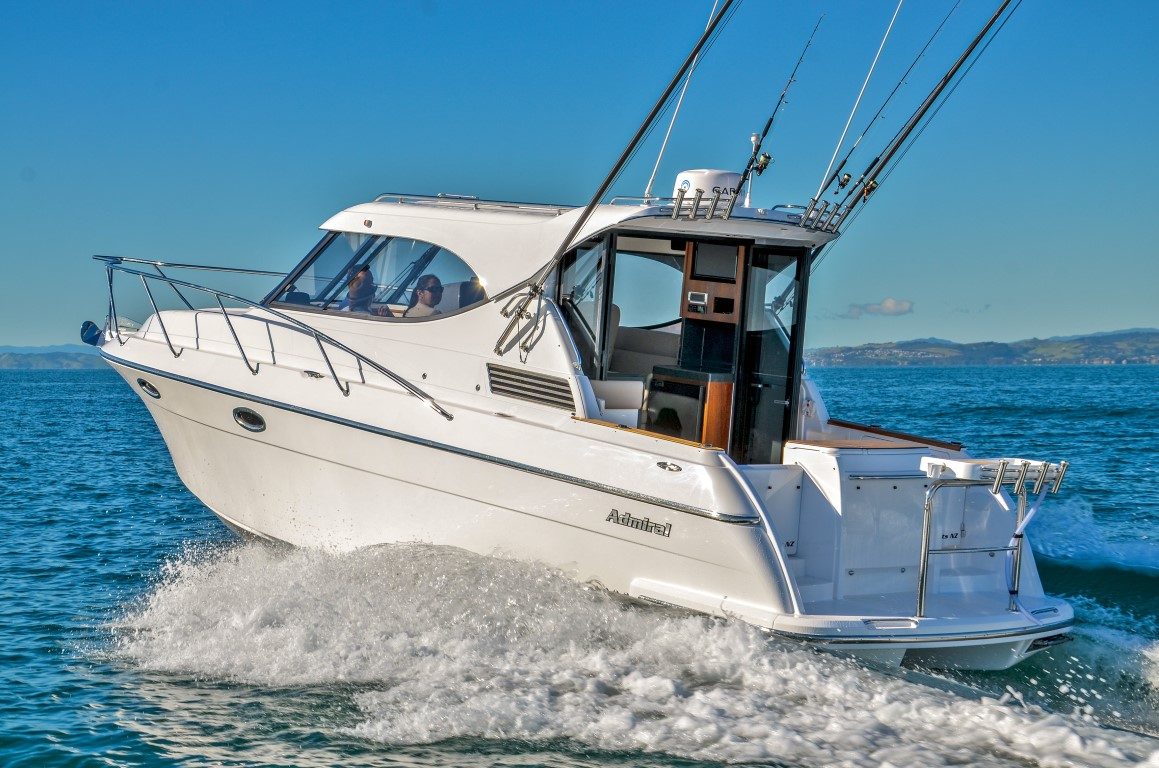
For the Admiral’s builders – Hamiltonians Jason McKenzie and Steve Clement – the 10m Sports Cruiser has been a deeply-considered project nearly 10 years in gestation.
That focus is immediately apparent when stepping aboard; this is an immaculately-presented vessel. And as I crawled, poked and explored, it was clear that every centimetre on this little ship had been meticulously planned.
She feels and looks great. With the padded linings and leather furnishings (artworks in their own right) the ambience is welcoming – like a good, mature wine. Internal surfaces are carpeted or lined with pin-perfect vinyl, creating a quiet environment when under way. And witness the soft, rolled edges on every corner – no hard angles to catch you in a seaway.
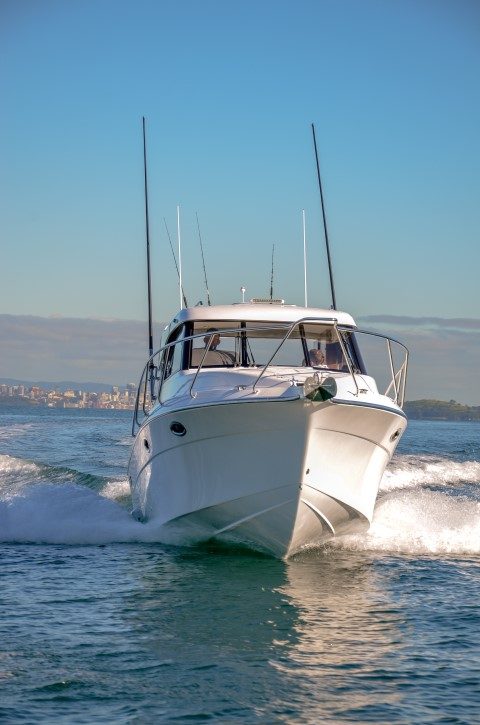
The labour of love began when McKenzie and Clement, detecting a gap in the local boating scene for a 10m Sports Cruiser, bought the Steadecraft hull moulds in 2007 – principally because of the design’s sea-keeping reputation. The marque’s 28-foot Sport and 33-foot Patrol models had been very popular.
With the hull catered for, fundamental design considerations included first-class accommodation, quality furnishings, the ability to catch and store fish, with reliable power and exceptional control in a seaway. And, it needed to be transportable – the boat would be used in Auckland for six months, and six in Taupo.
Building this first boat took just over a year and the end result is a vessel that succeeds on multiple fronts. Her public debut – at this year’s Hutchwilco Boat Show – attracted considerable interest.
She’s particularly well-designed for entertaining and hosting friends.
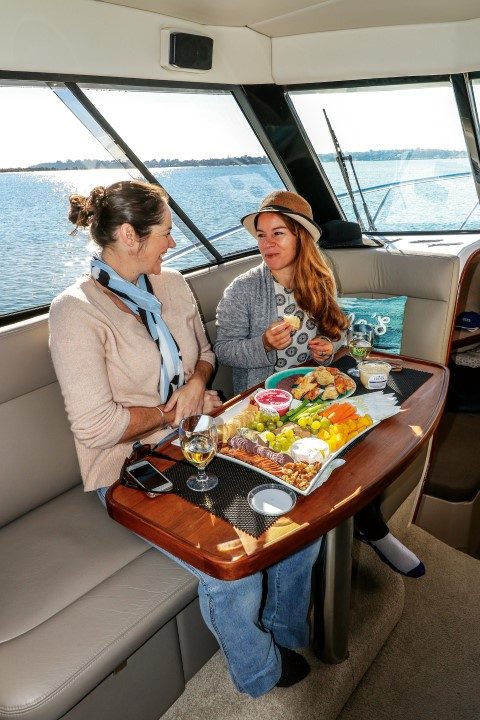
The galley’s L-shaped island holds a three-burner cooktop and oven, with waterproof surfaces and splashbacks. To the right, and below the superbly-upholstered port settee, is a large slide-out drawer where crockery and cutlery are stored in non-slip compartments.
Directly opposite to starboard, is the large-capacity fridge and entertainment console, with a drink-mixing wet area and splash-back. Food preparation is on black chip bench-tops, with wooden cupboards and storage cabinets in quality teak, giving strength, warmth and durability.
A Fusion stereo supplies the appropriate music.
BERTHS
For a trailerable boat, the Admiral’s accommodation is pretty impressive. She sleeps five – two double berths and a single bunk, configurable as a double and three singles. If needed, there’s space for more beds.
The master’s double is under the main saloon, and you enter down three carpeted stairs. Electrically, it all works superbly. There are double-switched lights and USB charging points for phones.

I really like the boat’s moulded ‘tiled’ wet areas. There’s one in the head/shower facility, for example, and while it looks very classy, it’s all enormously practical. In all, says Clement, 68 moulds were built to configure the boat’s working areas. Headroom – throughout the vessel – is exceptional.
HELM
Pride of place is the leather-covered helm chair – on a Softrider pedestal with slider and moveable arms. It offers excellent lumbar cushioning, and it’s complemented by a foldaway foot platform if you prefer standing at the helm.
Up front, there’s great visibility through three large windows, each with a parallax wiper. Panoramic visibility is the theme all the way round – thanks to huge sliding windows. The cabin, incidentally, can be fully enclosed when the glass folding doors and retractable windows behind the galley are deployed. When they are, ambient noise is well-muted, and conversation is easy.
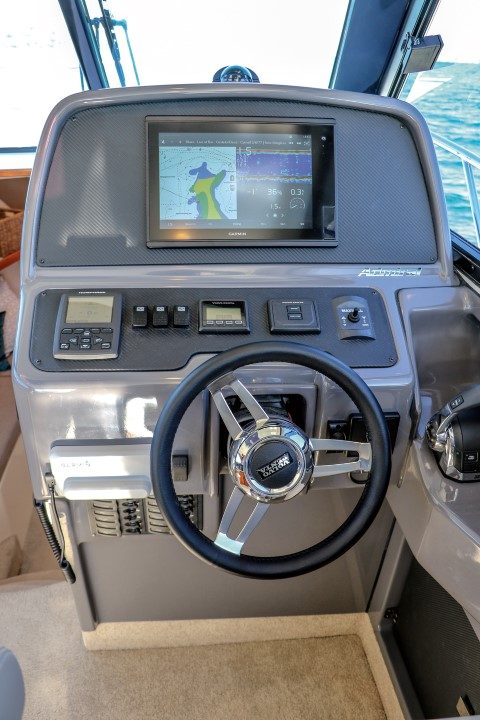
Data about the 260hp Volvo Penta engine and its counter-rotating twin-prop stern leg is provided on a non-reflective Garmin 7412XSV – and navigating it is simplicity itself. Split-screens, radar, fuel pressure, hours, fuel usage and tank levels, sounder, chart-plotter, Fusion Stereo controls – they’re all instantly available.
And this can also be relayed to the entertainment monitor – should you wish to view it from the back deck, or while having lunch. Plenty of discreetly-positioned ports and hatch-panels offer great access to the wiring looms and plumbing systems.
ANGLER’S DELIGHT
The fishing zone (cockpit) is a canny piece of design.
The hardtop’s rear overhang juts out over the deck, and on top are eight rod holders, manufactured by Steelliotts Stainless Steel. My vote for the cleverest use of space is the overhead hatch, built into the overhang. It flips down exposing net, gaffs, boat-hook and tag-poles, neatly clipped into place – accessible and yet completely out of the way of the deck activity when landing fish.
In the panels on either side, are emergency kits and storage, ideally suited to all those towed arrays. Two floor hatches either side of the engine bay give huge capacity for life-jackets, and safety gear. A movable upholstered bin offers seating and even more fishing gear storage.
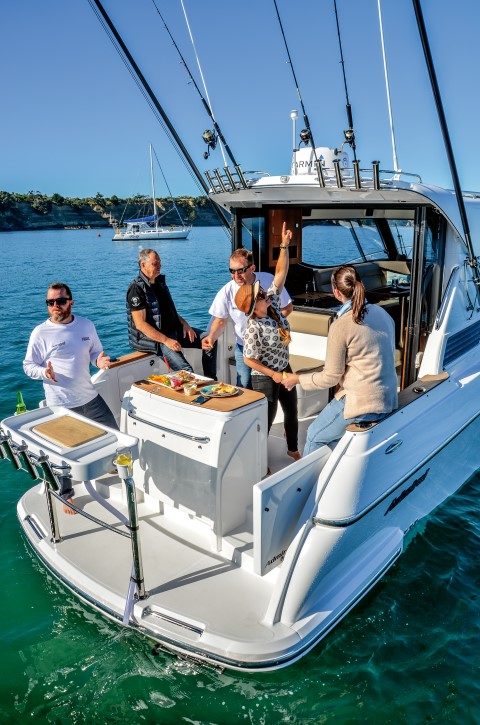
The cockpit’s central hatch is for the engine bay, and lifting it provides easy access to fuel filters and electronic what-have-you. Hydraulic struts take all pressure off lifting and lowering. To the rear, very solid transom doors swing open outward and are held that way with magnetic contacts.
These are easily removable for landing a big marlin, as McKenzie and Clement did on the boat’s maiden voyage. (The engine has an irresistible ‘attractor’ note in the water, one might think?)
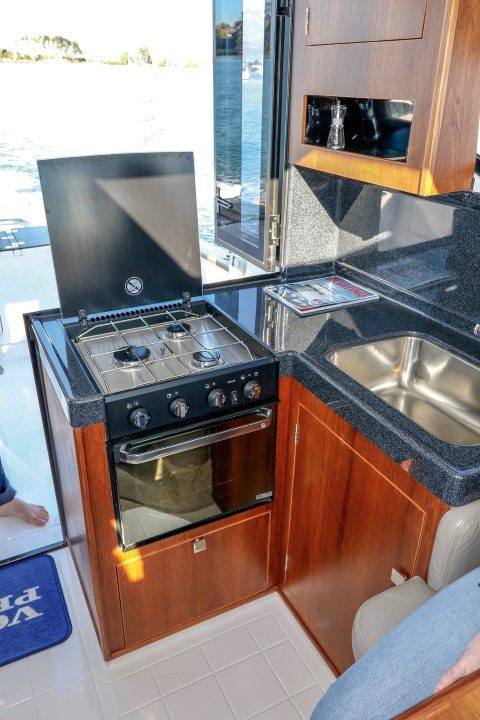
Around the bottom edge of the teak-topped gunwales, deep toe cut-outs increase the apparent size of usable deck, allowing angler access right to the edge, for thigh support. Blue lighting around the deck area at night is both attractive and practical, enhancing night vision rather than blindness. Underwater lights also attract fish – and look damn good at anchor.
Game poles are rigged either side and the finish of the boat is, quite simply, superb. In the middle of the rear deck is a transom-island, again covered in ‘working surface’ solid teak, with two hinges, which lift open to reveal a deep, live bait tank on the right, and a custom fitted deck barbecue on the left.
There’s a hot and cold shower on the deck, and a portofino stern with a strong baitboard, atop strapping stainless mounts. This is equipped with four rod holders, as well as a pipe draining fish-guts to the sea.
Behind the sliding sunroof is an almost invisible solar panel array, perfect for trickle-charging the batteries, and a Garmin Raydome.
PERFORMANCE
Driving the boat back home to the marina, I enjoyed playing with the controls and analysing the engine data, and with the engine purring along quietly while we talked, I barely noticed our speed – 27 knots.
For interest’s sake, and in the name of science, I threw the boat into a tight starboard loop, there was a fabulous bite in the front as we pulled round in a stable arc, but at nearly full lock managed to make the big sternleg cavitate for a fraction of a second. This was quickly fixed by trimming the sternleg a little.

Solid power pulls the 5.5-tonne sports boat up on the plane in seconds. The Humphree X Series self-leveling trim-tabs system works to break tension and is something of a revelation in both the transition to plane, and the auto correction, made evident as we headed into a stiffish breeze that momentarily lowered the starboard front quarter on the return home.
For a fairly substantial girl, she can certainly lift her skirts and fly when pressed. Best speed is 32 knots.
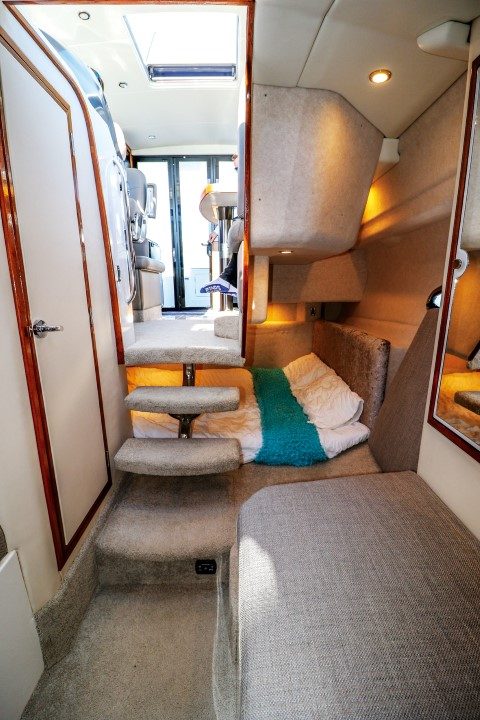
This cruiser weighs 4.2 tonnes dry and a touch over 5.5 when fuelled with 650 litres of diesel and 370 litres of water. She has leveling tanks and the capacity to hold 105 litres of black-water as well.
The objective for the Admiral project was to deliver a boat that encompasses fishing, family, holidays, entertaining and offshore capability in equal measures – in a modern, high quality configuration. These chaps have hit their target perfectly.
‘Behemoth’ is a word which springs to mind or, perhaps more nautically, ‘leviathan’.
White Pointer has earned the respect of discerning customers in New Zealand and Australia, attracting a loyal and ever growing following for its high-quality, rugged and totally dependable aluminium trailer boats.
The hardtop SP635 shares the same underpinnings as the popular SF 635 which was a completely new model back in 2020.
The pride and joy of a multi-generational family, Bliss resides on a pier that’s home to a couple of other Elite motor launches – Sandspit Marina is a hot-spot for the Bill Upfold-designed vessels, with several calling this small marina home.